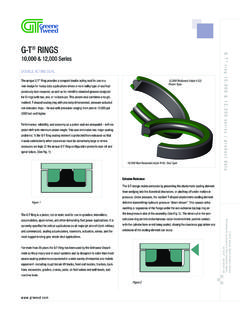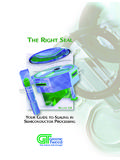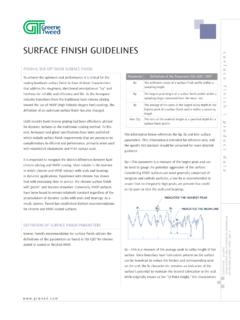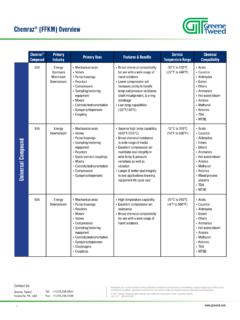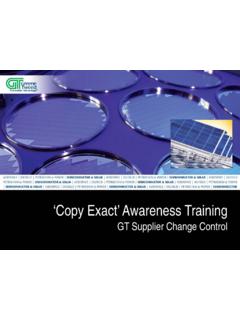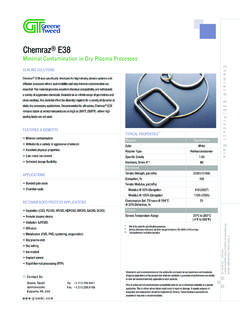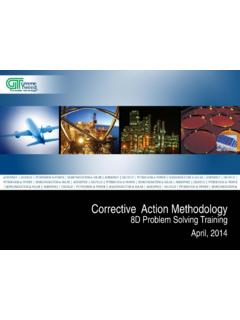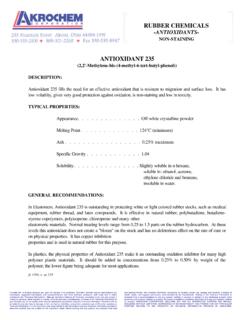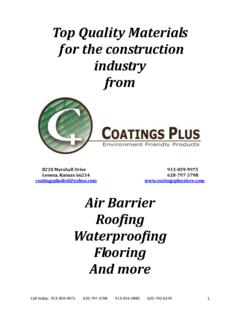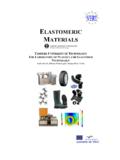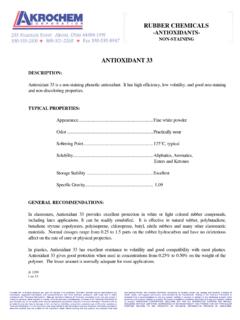Transcription of CHEMICAL COMPATIBILITY GUIDE - Greene Tweed
1 CHEMICAL COMPATIBILITY GUIDEE lastomeric Compounds123 CHEMICAL COMPATIBILITY GuideHIGH-PERFORMANCE MATERIALSG reene, Tweed offers customized-engineered components that optimize the total system. We have 100 years of experience developing high-performance materials for a range of industries, from medical, aerospace and defense, to fluid handling, oilfield and semi-conductor. We currently manufacture more than 300 unique elastomeric compounds and over 300 plastic production compounds from eight distinct plastic , Tweed formulates a variety of compounds to meet specific charac-teristics such as durometer, modulus, compression set, temperature, fluid COMPATIBILITY , etc.
2 Because we believe in collaborating with customers to match the specific needs of their applications, we can customize one of our many compounds to extend the performance of any process. Our engineers work side by side with customers to design the best solution for each individual , Tweed partners with customers to provide reliable, efficient answers to their application needs. With offices in the Americas, Europe and Asia, our customers can receive technical support from people who speak the same language. As a world-class leader in the design and manufacture of high-performance materials and customized-engineered components, we leverage our expertise in a variety of markets and products to give our customers the most innovative and cost-effective solutions to their demanding applications.
3 To learn more about what Greene , Tweed can offer, visit our website at the right elastomer and seal design to optimize system performance is a challenging task. This COMPATIBILITY GUIDE addresses only one aspect of the challenge the ability of the seal material to resist the contacting fluid. Greene , Tweed offers all of the elastomeric materials shown in this GUIDE to meet your most chemically resistant of these materials is Chemraz , a perfluoro-elastomer combining the broad, almost universal CHEMICAL resistance of PTFE with the resilience of elastomers. When coupled with precision seal design, Chemraz components represent the ultimate in elastomeric , when faced with the relatively high initial cost of such seals, the design engineer usually conducts a cost to use versus price to purchase review to establish value in use.
4 Our design experts are available to assist in choosing the right elastomer for each unique application. Simply fill in the information on the engineering form (page 69) and fax it to THE COMPATIBILITY GUIDEThe ratings contained in this GUIDE (see chart on the next pages) are based on existing published data, laboratory soak tests, and informed decisions on the part of Greene , Tweed personnel. Most ratings are based on ambient temperature, low pressure, and 100 percent concentrations. Exposure conditions differing from stated conditions could affect these is important to recognize real-world differences when applying laboratory and empirical information to actual field situations.
5 Soak tests usually employ full immersion of the test sample, in a pure fluid, at room temperature, without pressure or other stresses. In actual service, however, the seal is likely to experience a mixture of fluids, be exposed only on one edge, be compressed in a sealing gland, and/or be subjected to process pressure, elevated temperatures, and possibly abrasive particles. When stressed in these ways, the fluid attack on an elastomeric seal is almost always other factors can come into play to affect seal performance in actual field conditions. Some elastomer compounds shrink instead of swell in certain fluids. This phenomenon, coupled with high compression set, can result in seal leakage following thermal or pressure cycling.
6 Seals behave differently in dynamic applications than in static conditions. Replacing one elastomeric seal of a given size with another seal of the same size made from a different elastomer may not be successful because of differences in their physical properties rather than simply their fluid , Tweed offers a broad range of elastomer compounds. This booklet is only a general GUIDE . It cannot account for differences in the plasticizers, fillers, or curatives existing between different compounds of the same elastomer. Specific recommendations can only be made when the design and exposure conditions are provided for consideration by experienced seal suitability of all seals and seal materials should always be tested.
7 Greene , Tweed encourages such testing and will provide test specimens to facilitate products ( , Fluoraz , Fluorosilicone and Chemraz) should not be exposed to molten or gaseous alkali metals such as potassium or sodium, since an extremely exothermic reaction may 1 Perfluoroelastomer FLUORAZ TFE/PropyleneFluoroelastomer VF2 HFPE thylene PropyleneNitrileEpichlorohydrinHydrogena ted NitrileNeoprenePolyurethaneSiliconeFluor osiliconeRATING SCALE1.
8 Excellent; recommended for both static and dynamic Good resistance; usually satisfactory in static applications; might work in dynamic Limited resistance; might work under certain Not recommended for No rating due to insufficient = Poor F = Fair G = Good E = Excellent ELASTOMER TEMPERATURE RANGE ELASTOMER TEMPERATURE RANGE Epichlorohydrin -65 F to 250 F (-54 C to 121 C) Fluorosilicone -100 F to 400 F (-73 C to 204 C) Urethane -65 F to 225 F (-54 C to 107 C) Silicone -150 F to 500 F (-101 C to 260 C) Neoprene -65 F to 250 F (-54 C to 121 C) FKM Fluorocarbon -40 F to 450 F (-40 C to 232 C) Nitrile -75 F to 250 F (-59 C to 121 C) Fluoraz TFE/Propylene 32 F to 500 F (0 C to 260 C) Hydrogenated Nitrile -40 F to 350 F (-40 C to 177 C)
9 Chemraz Perfluoroelastomer -22 F to 600 F (-30 C to 316 C) Ethylene Propylene -65 F to 300 F (-54 C to 149 C)PROPERTIESFFKMFEPMFKMEPDMNBRECOHNBRCRA USIFSIA brasion ResistancePGGGEGGGGEPPAcid ResistanceEEEGFFGEFGPFGFGC hemical ResistanceEEEEFGGFGFGFGEECold ResistanceFPPFPGEGGEGFGGEGEE lectrical PropertiesEFFGFFFFFGEEF lame ResistanceEEEPPFGPGPFGHeat ResistanceEEEEGFEGPEEI mpermeabilityGGGGGGEGGGPPOil ResistanceEEEPEEEFGGPGGO zone ResistanceEEEEPEGGEEEESet ResistanceGGGEGEGEPFGEFFGEGETear ResistanceFPFFGEFGGFGFGGEPPT ensile StrengthFGGEGEGEGEGEGEPFW ater/Steam ResistanceE/FEFGEFGFEFPFFW eather ResistanceEEEEFEGEEEECOMPARISON OF PROPERTIES OF GENERIC ELASTOMERSC hemical COMPATIBILITY 2 AAbietic Acid111111111111111 Acetaldehyde1111112311123116 Acetamide11111223
10 411111118 Acetanilide1 11111111111111 Acetic Acid, 30%1111111111122113, 17 Acetic Acid, Glacial11111111111221117 Acetic Anhydride111111111112211 Aceto Cyanohydrin1111 11111111 111 Acetoacetic Acid (Acetyl Acetic Acid)111111111111111 Acetone (Dimethylketone, Propanone)111111111111111 Acetonitrile (Methyl Cyanide)111111111111111 Acetophenetidin111111111111111 Acetophenone (Methyl Phenyl Ketone)11 1111111111111 Acetotoluidine111111111111111 Acetyl Acetic Ester11 1111111111111 Acetyl Acetone111 111111111111 Acetyl Benzene (Acetyl Phenone)111111111111111 Acetyl Bromide111111111111111 Acetyl Chloride111111111111111 Acetyl Nitrate111111111111111 Acetylene11111111111111112 Acetylene Tetrabromide111111111111111 Acetylene Tetrachloride11 1111111111111 Acetylsalicylic Acid1 11 111111111111 Aconitic Acid1 111111 1111221112, 17 Acridine11111111111221112 Acrolein (Acrylaldehyde, Allylaldehyde)11 1111231112311 Acrylaldehyde (Allylaldehyde, Acrolein)

